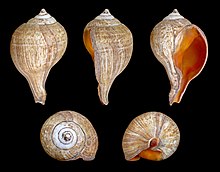Turbinella pyrum
| Turbinella pyrum | |
|---|---|
 |
|
| Five views of a shell ofTurbinella pyrum with its periostracum intact | |
 |
|
| Three carved dextral shells of Turbinella pyrum from 11th century India, see shankha | |
| Scientific classification | |
| Kingdom: | Animalia |
| Phylum: | Mollusca |
| Class: | Gastropoda |
| (unranked): | clade Caenogastropoda clade Hypsogastropoda clade Neogastropoda |
| Superfamily: | Muricoidea |
| Family: | Turbinellidae |
| Subfamily: | Turbinellinae |
| Genus: | Turbinella |
| Species: | T. pyrum |
| Binomial name | |
|
Turbinella pyrum Linnaeus, 1758 |
|
| Synonyms | |
|
Buccinella caerulea Perry, 1811 |
|
Buccinella caerulea Perry, 1811
Turbinella pyrum, common names the chank shell, sacred chank or chank, also known as the divine conch, sometimes referred to simply as a conch, is a species of very large sea snail with a gill and an operculum, a marine gastropod mollusk in the family Turbinellidae. This species occurs in the Indian Ocean.
The name "chank" for the shell of this species is derived from the Indian word shankha, the divine conch. The old generic name was Xancus. The Dutch used to call them chianco. [1]
This species is found mainly in the Indian Ocean.
The shell of this species is massive, with three or four prominent columellar plicae. It is usually pure white under a heavy brown periostracum, but it can also be a pale apricot color. It can sometimes be dotted with dark brown. [2]
Shells of the normally left-handed western Atlantic Ocean species Busycon contrarium are sometimes sold in imitation of the rare left-handed shells of the Turbinella species. [3], [4]
...
Wikipedia
